7 best restaurant reservation systems 2025: Pros, cons, cost
Skip the article and turn takeaways into action by scheduling a call with our team.
Restaurants looking to make the most out of the guest experience in our modern era will want to adopt an online restaurant reservation system. Where once the choices were few, there are now a number of different online reservation systems. So where to start?
Online reservation platforms can streamline systems that were previously clunky and relied on pen and paper. They come with all sorts of perks, too: cutting down on no-shows, providing real-time info that allows for walk-ins, allowing for automation of reservations, reducing cancellations, and more.
As with any important decision, some research goes a long way. After all, there are a number of differences between the platforms available. Some companies charge a cover fee for each reservation placed, while others charge a one-time purchase price. Others, especially those that offer integration with a suite of management tools, charge a monthly fee. You might also see combined pricing or customizable pricing platforms.
Here are seven of the top restaurant reservation systems along with their pricing and features so you can make an informed decision on software for your restaurant.
7 best online restaurant reservation systems
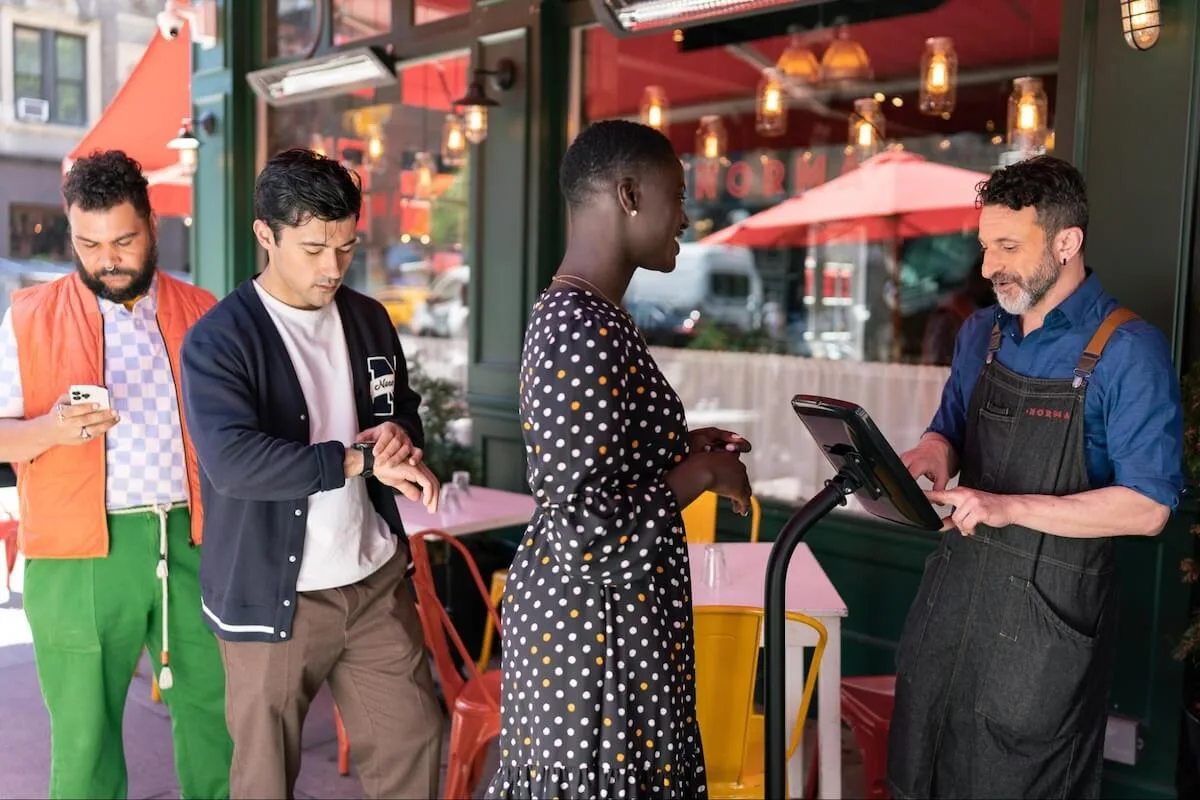
1. Yelp Guest Manager
Yelp Reservations is among the most popular restaurant reservation systems and is an organic part of the larger system of management tools that make up Yelp Guest Manager. Restaurateurs who use Yelp Guest Manager have the advantage of POS integration, table management, advertising, links to their restaurant website, and fully customizable service options. Yelp Guest Manager users get a dedicated onboarding manager for full-time customer support during the onboarding phase.
Pros:
- No cover fees: Reservations are included as part of the Guest Manager suite of management tools
- Super-accurate wait times and low no-show rates: This makes life for both customers and restaurateurs easy
- User-friendly features
Cons:
- Works best for well-established restaurants with strong reviews: It can take time to build up a reputation
Pricing: Starts at $129/month, no cover fees
2. OpenTable
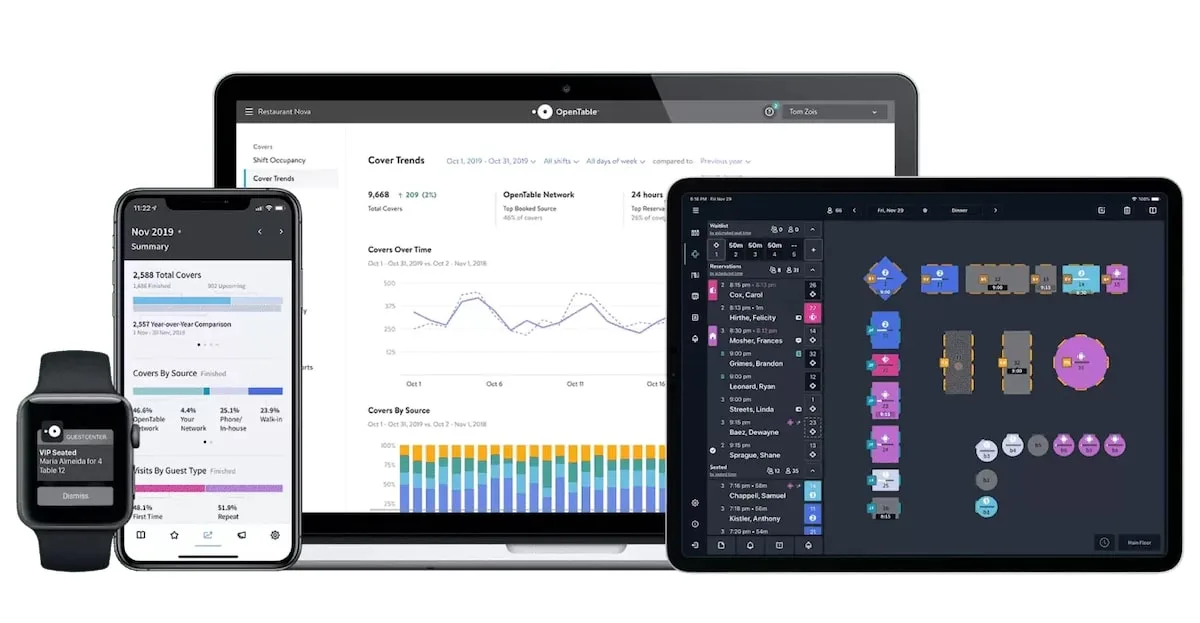
OpenTable is well-known as the first big online reservation provider. Since starting the first online booking service in 1998, it has grown into a major presence in the restaurant industry. OpenTable has expanded its offerings to cover most restaurant operations in recent years.
Pros:
- Established reputation
- Broad reach
Cons:
- High cost
- Multiple fees (setup fee, monthly fee, and per-reservation fee)
Pricing: $149-$499/month + per-reservation fee
3. Resy

Resy, now owned by American Express, was the first major competitor for OpenTable. It offers largely the same functionality, but focuses on a mobile app. It streamlines ticketing and waitlist management into the same system. Customers can also add themselves to a waitlist or communicate via text message with the restaurant.
Resy limits itself to a selective number of high-volume and upmarket restaurants in large urban areas only. At the same time, Resy incorporates a number of value-added features not found on several other systems.
Pros:
- No setup fees
- Advanced customer relationship features
Cons:
- Limited to high-end restaurants in major cities
Pricing: Monthly fees from $249-$799
4. Tock

Tock offers a full-feature POS system. It features table booking, contactless credit card payments, and floor plan management as part of its feature-rich suite. If online reservations are not available, it also features updated wait times and allows customers to add themselves to a waitlist and receive updates. However, it lacks order ticketing for the kitchen, and instead interfaces with additional software to handle that end.
Pros:
- Integrated POS functionality
- Lower base price
Cons:
- 2% fee on online sales
- Additional software needed for full functionality
Pricing: $199/month + 2% online sales fee or $699/month flat fee
5. TouchBistro
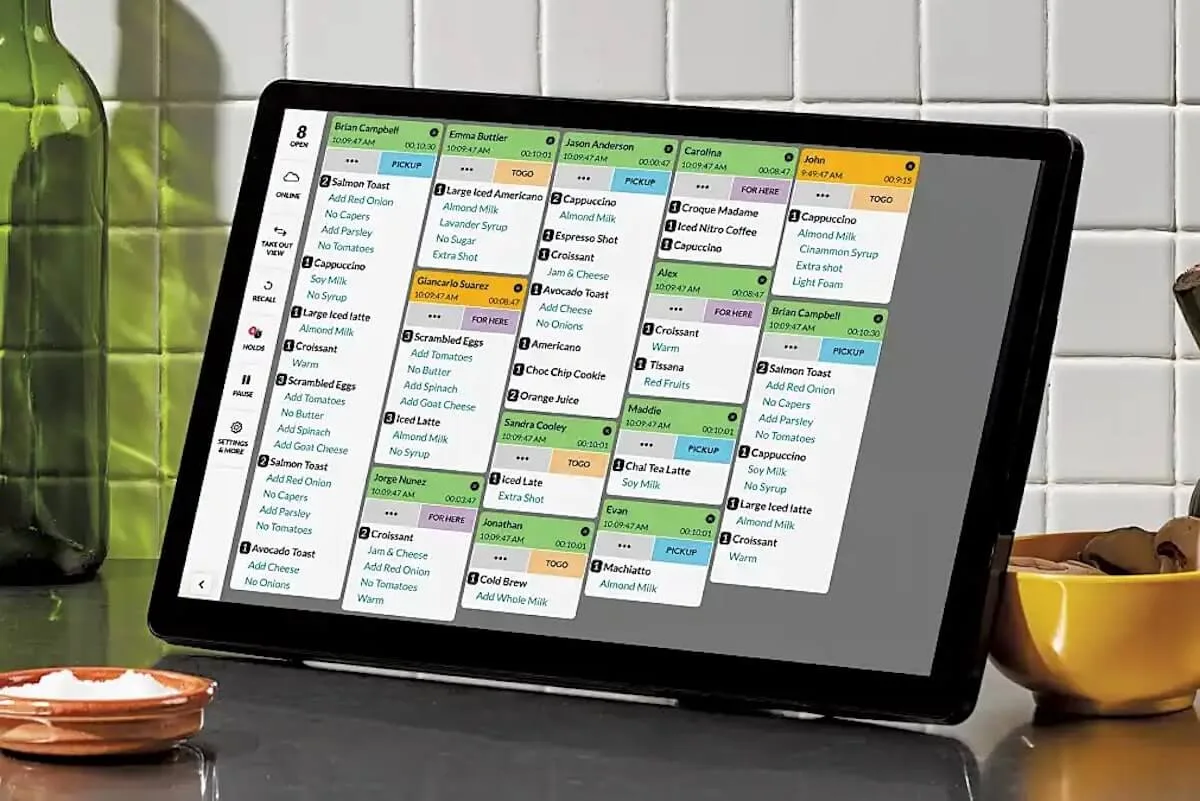
TouchBistro is one of the newer kids on the block when it comes to reservations, though they’ve quickly expanded into full-package restaurant software. TouchBistro offers a POS, back-of-house management tools like kitchen displays and profit management systems, and guest engagement including online ordering and loyalty systems. Its newness means it has limited reach, however.
Pros:
- Comprehensive restaurant software
- Frequent feature updates
Cons:
- Limited reach
- Less robust marketing tools than other reservation platforms
Pricing: $229/month + additional costs for extra features
6. Toast
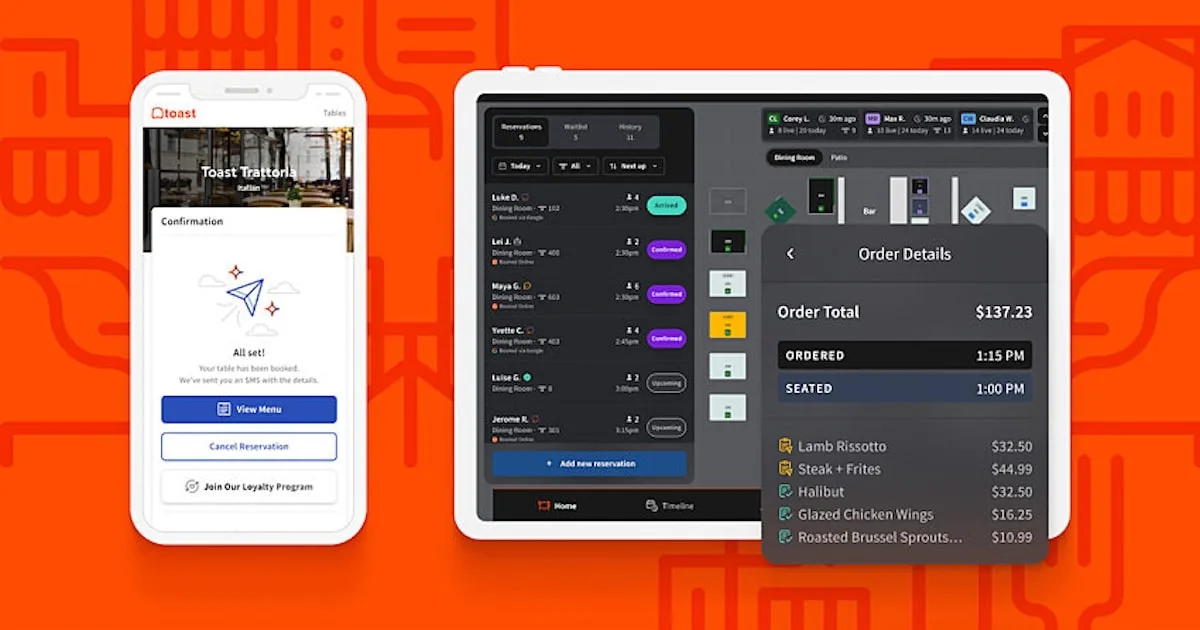
Toast offers a full front-of-house platform, including a reservation management feature called Toast Tables. It syncs with its other software offerings, like employee management, email marketing, customer loyalty, and kitchen display systems. Toast’s not-always-disclosed fee structure can add up if restaurateurs want full functionality.
Pros:
- Seamless integration with Toast POS and kitchen display system
- No cover fees
Cons:
- Proprietary payment system
- Hidden costs
Pricing: $50/month (basic plan) to $199/month (plus)
7. EatApp
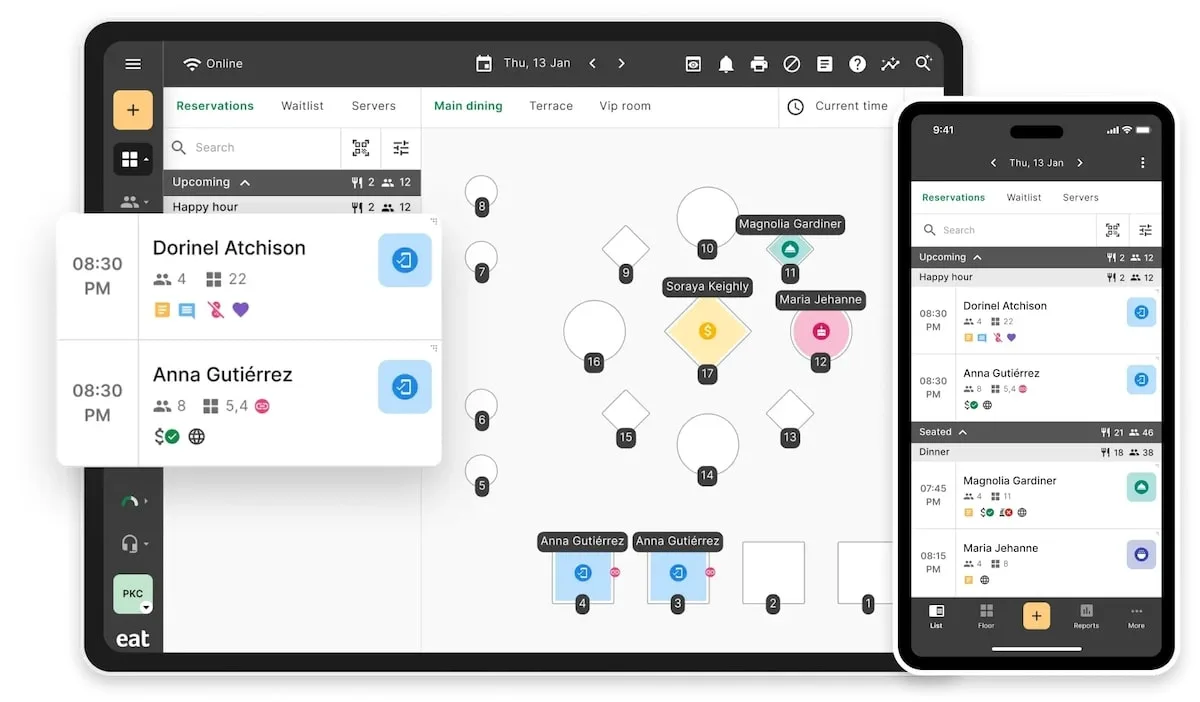
EatApp, originally hailing from the United Arab Emirates, is making significant inroads in North America. It offers a full front-of-house package, including reservations, waitlists, and POS integrations. Its range of pricing is arranged like add-ons for a new car, where restaurateurs can pay extra for specific features. Those who want a bare-bones reservation management tool will be pleased with its low entry price point.
Pros:
- Flexible pricing structure
- Free plan available
Cons:
- Internet-dependent
- High fees for Google and TripAdvisor bookings
Pricing: Free for 30 reservations, then $49-$229/month + add-ons
Key features to look for in a restaurant reservation system

When choosing a system, restaurateurs should look for some key services that can make or break a platform’s viability. Restaurant booking systems come in many shapes and sizes, and offer different features that may or may not be necessary for your business.
Real-time table availability
When you provide real-time table availability information to diners, you keep guests informed and also have a good chance of getting new guests in the door. Instead of having a host tied to the phone telling callers how long the wait time (probably, hopefully) is, your software can automatically calculate the most accurate wait time. For reference, Yelp Guest Manager quotes wait times with up to 92% accuracy.
That means no more moment of shame when you have to tell a walk-in party that sorry, their table STILL isn’t ready—they’ll have an accurate wait time at their fingertips from the moment they join the waitlist.
If a customer can hop on your waitlist at the push of a button and know they can get a seat in X amount of time, their lives will be easier and you’ll fill more seats. That means less empty tables, more table turns, and more money in everyone’s pockets.
Integrations with other restaurant management tools
You want a restaurant reservation system that pairs with vital tools. POS integrations, for example, can make tableside payments by credit card easy while syncing all guest data in one place. Pairing with POS systems means a lot less busywork behind the scenes, and overall improved ease of use.
Naturally, the best restaurant reservation systems will sync with table management tools to give front-of-house (FOH) staff maximum flexibility. A reservation system that works with a customizable floor plan helps transition online bookings to in-person dining smoothly.
Pairing with online ordering systems helps streamline operations in the back-of-house (BOH), since order ticketing will be organized chronologically. Clogs in BOH restaurant operations can lead to a negative dining experience for both in-house and delivery or takeout customers.
Customer communication tools
You’ll want to be able to talk with customers once they’ve made a table booking. So, customer support tools like SMS notifications and two-way SMS messaging will ensure you can speak to them directly and field any questions they may have. Automated messaging for reminders of booking times will keep guests up-to-date.
Marketing insights and loyalty programs
Some reservation systems work effectively as customer relationship management (CRM) tools, creating a guest database full of information that restaurateurs can parse to gain insight into their operations. You can make decisions based on data, not hunches, when you have easy access to sales trends and guest demographics.
Sales forecasting can give you a more informed picture of your staffing needs or the best inventory management plans for special events and busy or slow seasons.
There are many more ways to develop a loyalty program than there used to be, many of which can sync with your reservation system. For example, restaurants can now develop a custom mobile app as a loyalty program. Frequent diners who book via reservations can be given specific rewards at the restaurant’s discretion. Other options, like social media rewards programs, can be leveraged via platforms like Yelp Connect to turn new customers into regulars.
What is a restaurant reservation system (and what is it not)?
Still a bit lost?
Here’s what you can count on in a typical reservation system, at-a-glance:
- Online reservations
- Waitlist management
- Table management
- Notes/special requests
- Integration with POS systems
- Revenue tracking and analytics
Here’s what is not commonly included in this type of software:
- Menu management
- Kitchen operations management
- Employee management (HR, payroll, scheduling)
- Accounting software
- Marketing and loyalty programs
Why you need an online restaurant reservation system

Do you really need restaurant reservation software? Can’t you just stick to your tried-and-true pen and paper system or Excel sheet and your whip-smart hosts?
It may be tough to think about an added cost when the budget is tight, but from the restaurant operations side, the benefits win out. The best restaurant reservation systems will:
- Reduce no-shows
- Provide real-time wait information for walk-ins and waitlist management
- Reduce host busywork, freeing them up for guest hospitality, helping servers, and other vital tasks
Customers will also love that you have a quick and easy reservation management system and can turn them into regulars. Online reservations help diners in these ways:
- A simplified booking process makes reservations easy, increasing the likelihood that they’ll book a table
- Accurate wait times prevent frustration and delays in returning back when it’s their turn
- An enhanced dining experience: When everything is easy, dining out is more fun
How to choose the right system for your restaurant
So, out of all these great reservation systems, which one is your perfect match? Here are some questions to consider with your team:
- How many table reservations do we expect to get from a reservation platform?
- What is our budget for a reservation system, and how does it fit into our overall budget?
- What features do we need out of our reservation software? What features can we live without? (e.g., do we need social media marketing tools, loyalty programs, or restaurant website widgets?)
- How can the reservation system scale with our future growth?
The takeaway on dining in
The seven platforms we covered here all have unique features and can appeal to different restaurants based on their needs. You and your team will want to carefully consider exactly what you need—both in terms of budget and features—when choosing what system is best for you. Take the time to understand your priorities so you can go into the decision knowing exactly what features matter to you.
If you’re in limbo and want to see one platform in action, schedule a consultation with experts in Yelp Guest Manager to get this party started.